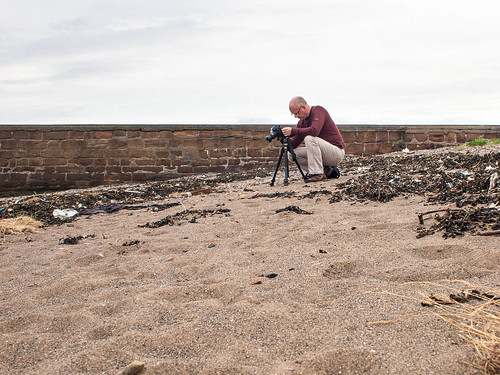“If you are inauthentic about the true reasons or motivations behind a piece of your work, then this will be apparent to the viewer.”
With these words fixed firmly in my sights it’s time to think seriously about what to do with this assignment. Why do I take photos of junk on a beach? How does it relate to my previous assignments? How do I convey any of that? How does it relate to the research I’ve been doing on curation and archaeology? How do I present it?
Why do I take photos of junk?
Let’s be honest with myself from the outset – it’s not to offer a critique of documentary photography. My brother once asked if I enjoy taking these images, and the answer is “I do.” I enjoy the sheer randomness, the occasional odd juxtapositions, and if it doesn’t sound too grandiose, I like the idea that the remnants of society are washing up on its edges. It’s quite contemplative – wandering along the tideline looking at clothing; and remnants of furniture; and bottles and tins; and slag and coal left behind by dead industries; and dead livestock. I once even found a message in a bottle which I inexplicably failed to photograph – such was my delight!!

And what do I contemplate…generally the provenance of the objects I’m looking at. Are they local, do they tell me anything about what’s happening locally – or have they travelled some huge distance to wash up on this tiny strip of beach in West Cumbria? This morning I spoke to a woman who claimed she’d once found an arm on a beach – happily I’ve not been that unlucky. The occasional dead sheep or hen is about it for me – but I have found a whole range of things that make me wonder how it got there, and what its story is.
How does it relate to my previous assignments?
In broad terms this relates to some of the stuff I was doing In Landscape 2 – I’m intrigued by the idea that the beach is effectively the defining edge of our living space, analogous to the way Edgelands are the defining edge of urban life. Coming closer to home, I think the links with Assignment 3 are clear enough, in that it makes use of the debris on the beach, and objects in particular, which also ties it to Assignment 4. In 3 I was using the objects to explore an issue – how words and images work together to tell a story. In 4 the objects were themselves the subject of analysis – the challenge for 5 is produce a photo-essay, rather than a story, to capture something of the essence of my thoughts above, and to, perhaps, point up my interests in curation and archaeology.
How does this relate to my research interests?
This seems a good time to quote Berger again “”The photographic narrative form….is not concerned with events as facts – such as is always claimed for photography; it is concerned with their assimilation, their gathering and their transformation into experience.”
So I hopefully have to convey something of the “process” by which I gathered the pictures, and by the editing of the sequence – the curation – try to convey an honest impression of what I see.
How do I convey this? How do I present it?
My tutor suggested a book simply showing the objects, and this has genuine appeal. he suggested calling it something like “The Archaeologist” and this too has appeal – although it’s not actually my idea. I certainly need to capture some of the randomness, and some of the juxtapositions, which means it’s back to the contact sheets to look for new images. I think however, that I’m going to call it “Wonderful things”, after Howard Carter’s reaction to what he could see in Tutankhamen's burial chamber. I’ve no idea what caused that to drop into my head – but it hit me in the shower this morning and seems entirely apt. I will need a few more than the 15 images recommended to do the idea justice, but my tutor has indicated I shouldn’t be hidebound by that and as it is going to be in book form it shouldn’t be an issue.
My initial thoughts are that something as random as a Provoke era Japanese magazine is heading in the right direction although I’m not convinced my design skills are up to it. Kawada’s “The Map” is a less chaotic example and I’m reassured by the seemingly random collections of images that feature in photo books in the BJP. I also think it needs to include an image of me or at least an explicit reference to the manner in which the images are collected, to point up the nature of the activity. I also wonder if a formally bound book is a little too structured, and perhaps hints at a completed work – so i may think about hand stitching my own “magazine” – certainly I think a magazine feel is more appropriate.
References
Berger, J. & Mohr, J., 1982. Another Way of Telling. New York: Pantheon Books.
Farley, P. & Roberts, M., 2011. Edgelands. Kindle ed. London: Jonathan Cape.
No comments:
Post a Comment